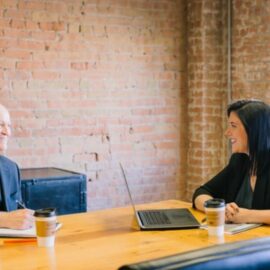

This article is an excerpt from the Shortform book guide to "Capital in the Twenty-First Century" by Thomas Piketty. Shortform has the world's best summaries and analyses of books you should be reading.
Like this article? Sign up for a free trial here .
What is wage inequality? Why is wage inequality rising?
According to Thomas Piketty in Capital in the Twenty-First Century, wage inequality is inequality of income from labor. Many factors contribute to wage inequality, and it’s not getting any better.
Read below for a basic overview of wage inequality, as explained by Piketty.
The Role of Wage Inequality
Piketty identifies wage inequality as a significant driver of overall inequality. He writes that economic inequality derives from wage (or income) inequality and capital (or wealth) inequality. As we’ve seen, capital inequality is inequality of income from capital due to unequal distribution of ownership of assets or unequal rates of return on different classes of assets.
What is wage inequality? Wage inequality, on the other hand, is inequality of income from labor. There is a multitude of factors at work in producing wage inequality—skill differences; hierarchical positions within organizations; educational attainment; as well as factors like age, race, and gender discrimination.
Human Capital and the Rise of Inequality
Other writers have emphasized the roles of skill and access to education—sometimes called “human capital”—in widening wage inequality. In Naked Economics, Charles Wheelan writes that human capital explains much of the rise in inequality.
Wheelan argues that the divergence in incomes corresponds with a divergence in the levels of human capital at either end of the economic spectrum and an economy that increasingly rewards skilled workers—that is, those with human capital. Almost every industry has shifted toward a need for computer skills, which has decreased the need for low-skilled workers but increased the need for high-skilled ones. For example, automatic teller machines have made many bank tellers redundant but at the same time have created jobs for computer programmers who design the machines.
However, because computer training and other such capital-building investment is often unaffordable for those at the very bottom of the social-economic ladder, they get shut out of the fastest-growing segments of the economy, leading to increased inequality between the upper and lower echelons of society.
Wages Are Driving the New Age of Inequality
Piketty writes that the history of economic inequality in the advanced economies of Western Europe and North America followed a distinct historical pattern—an era of high inequality in the period before World War I, followed by a significant compression of the wealth distribution in the decades after World War II, and a new age of rising inequality beginning in the 1980s and continuing to the present.
But he notes an important difference between the earlier period of massive inequality during the 18th, 19th, and early 20th centuries and the one we are living through today. Before World War I, a much larger share of the total income of the richest people came from ownership of capital assets—dividends, rents, interest on government bonds, and capital gains.
(Shortform note: The 19th century in particular was an era of staggering inequality. In the PBS documentary The Gilded Age, the filmmakers observe that in 1897, the richest 4,000 families in America controlled as much wealth as the other 11.6 million American families combined. But, as Piketty argues, we may be returning to a similar economic paradigm. In November 2017, the three richest individuals in America were as wealthy as the bottom half of the population.)
Since the 1980s, however, he observes that the top decile and even the top centile’s income primarily comes from highly compensated labor. He argues that skyrocketing salaries for high-ranking executives and managers (most notably in the finance sector) are driving today’s inequality. In this respect, today’s wealthy are different from their predecessors of the 18th and 19th centuries. They are less a class of rentiers than they are a class of highly compensated salary-earners.
But regardless of its source, Piketty warns that the rich are only getting richer: In the US, the top decile increased its share of national income by 15 points, from 35 to 50% from the 1970s to 2010.
(Shortform note: We can see direct evidence of Piketty’s argument by looking at the extraordinary divergence between average CEO pay and average worker pay that has taken place in the US since the mid-20th century. In 1965, CEOs earned, on average, 21 times more than the average worker. By 1989, that ratio had nearly tripled to 61:1. And by 2020, a CEO at one of the top 350 companies in the country could expect to earn more than 351 times the salary of a typical worker. In total, from 1978 to 2020, CEO pay grew by an exponential 1,322%—more than the growth in the S&P stock market growth during that time and the relatively paltry 18% wage growth of the typical worker over the same period.)
Wage Inequality Is a Choice
Piketty argues that this wage inequality is a political and social choice that our society has made. He acknowledges that wage inequality is partially a function of workers’ productivity—how much they contribute to the firm’s marginal output—and that this marginal productivity, in turn, is determined by workers’ education and skill levels.
But ultimately, writes Piketty, the mechanisms that allow for such a degree of overcompensation are the result of social, political, and legal decisions—specifically, to accept and even celebrate what he sees as unjustifiable income disparities.
These include political decisions about where to set the minimum wage (or whether to establish one at all); the level of legal protections afforded to labor unions; the degree of progressiveness of the tax system; the generosity of the welfare state; and how much we choose to invest in quality, universal education.

———End of Preview———
Like what you just read? Read the rest of the world's best book summary and analysis of Thomas Piketty's "Capital in the Twenty-First Century" at Shortform .
Here's what you'll find in our full Capital in the Twenty-First Century summary :
- An analysis of incomes, tax returns, and estate tax returns across different countries
- How capitalism, by its nature, generates economic inequality
- How inherited wealth will soon account for more than earned income






